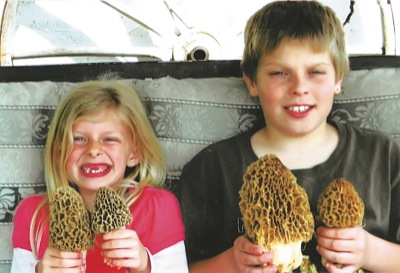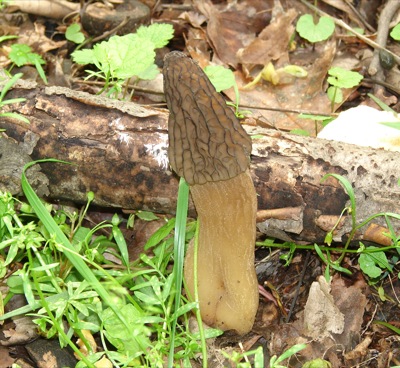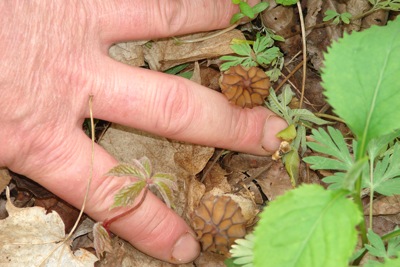Monday, May 11th, 2009
On the wild side
Soak before cooking
By Janie Southard

Submitted Photo
The Roberts kids, Hailey, 7, and Lucas, 11, show off the morel mushrooms their uncle found in his back yard near Mendon. Before cooking, mushrooms need to be soaked overnight in salt water. Wild mushrooms are home to tiny insects and dirt, so soaking in important. Never eat wild mushrooms raw.
There are more than 2,000 types of wild mushrooms in Ohio. Some are poison. Some aren't, and those are the ones that get people of all ages out in early spring searching for morchella, otherwise known as morel or sponge mushrooms.
Octogenarian Betty Schmitt of Mendon has been hunting mushrooms since she was a little girl living around Geneva, Ind. One of nine children, they all learned early to identify those highly-prized sponges.
"It was a family thing. We didn't have any money to go anywhere or do anything, so we'd go down to the river and fish. Or, in the spring, we'd all go out hunting mushrooms," Schmitt says.
Like the majority of Ohio fungus hunters, she's usually after the morel, which can be the smallish white/grays, or a 10-inch tall golden/yellow, or a black. Among the thousands of edible varieties in Ohio there are: chanterells, puffballs, shaggy mane, meadow mushrooms, chicken mushrooms, slippery jacks, spikes and others.
But there also are many varieties of poisonous mushrooms. Experts at the Ohio Mushroom Society say experience has been the best teacher: If you find it, cook it, eat it and live, then it's not deadly. An old saying is included on the OSU Extension Web site: "There are old mushroom hunters and bold mushroom hunters, but there are no old, bold mushroom hunters."
Schmitt, herself a grass-roots expert, has a pretty simple motto when it comes to mushrooms: "I don't pick anything I don't know."
The Extension site also dispels some old wives' tales of how to know good mushrooms. The following statements are not true: If it peels, you can eat it; all mushrooms growing on wood are edible; if squirrels or other woods creatures eat it, it's safe for humans; and all that grow in meadows or pastures are safe.
Especially deadly is the belief that parboiling, drying or pickling a mushroom can make it safe; or that all white mushrooms are safe. Both beliefs are false. In fact, the most common deadly mushrooms in Ohio are white.
Mushrooms grow in wet areas of the woods around decaying wood. They also grow in old orchards. They also grow in the middle of the lawn. Local folks who know for sure where there's patches of good mushrooms are absolutely not going to tell where it is. Don't even ask.
Hailey, 7, and Lucas, 11, Roberts are proud to show off the huge morels their Uncle Brett found in his lawn north of Mendon. He has never found morels before, but this year these beauties just popped up in his back yard.
But Schmitt says this is "an exceptionally good year for mushrooms."
"The weather has to be right. It needs to be cool and wet, no frost - in the 50s at night and upper 60s in the day; not sunny because the sun dries them out. The last couple years haven't been good. We had those dry springs and it got hot fast," she says.
Hunters all have their own idea of where to find the little fungi: When may apples flatten out; when the redbuds bloom; when violets bloom; when ash tree leaves show green. Or, they're out there in Ohio whenever you find them between late March and early May.
Schmitt says a lot of people go to Michigan for mushrooming.
"Those Michigan mushrooms are full of sand and you just cannot get it all out," she says.
If you do find them, keep notes, mark a calendar to remind yourself next year because they say mushrooms always grow in the same spot. Wait a minute, there are those who strongly believe mushrooms never grow in the same spot. If all else fails, go to the Internet where sightings of morels are posted at www.morelmania.com.

Photo by Janie Southard/The Daily Standard
Some call this a half-free morel mushroom. It is edible and found locally. Many people are looking for wild mushrooms now.

Photo by Janie Southard/The Daily Standard
These are called spikes, which some say is another variety of morel mushrooms. A whole lot of these have been found recently in western Mercer County. Those who know where they're found won't tell; so don't bother asking.






